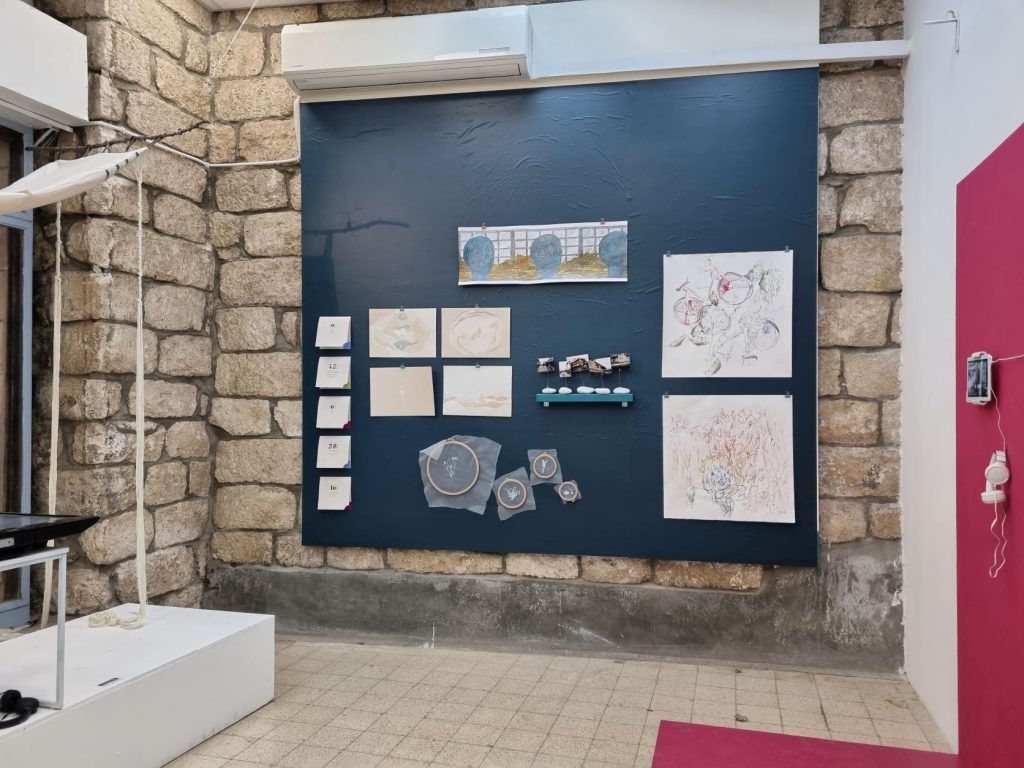After a week of wet winter weather in Jerusalem, Israel, the sun came out on Thursday morning, and I finally had a chance to walk to the Old City.

Nothing like the view from above the Kotel, Western Wall, with winter clouds hovering above. Sadly so few people were there to be able to enjoy it.

I was not early enough to see Santa on his camel at Jaffa Gate. But I did spot the last lone tree in the annual giveaway. The Municipality, along with JNF, gives away small pine trees each December to residents who arrive early.
I was on my way to see what was happening in the Old City, during what usually is a very busy time of year.
I decided not to share the empty streets this week. The lack of tourists, the closings, and corona news are all well known by now. The latest bad news – bird flu – may cause an egg shortage.

Looking into the Beit Midrash at Aish on the way to the roof view, the study hall was an impressive scene filled with young men studying.
The Torah has guided the Jewish people for millennia.
Exploring new ways to integrate its ancient words and writings into the skeptical 21st century has become a topic of lively and varied discussions.

Thursday Bar Mitzvahs were being celebrated in the egalitarian section of the Western Wall. It was good to see this section being used.

As you can see, the repair scaffolding has been removed. This is where a stone fell in the summer of 2018. Afterwards, the entire section was checked and the wall repaired.

In the Artist Colony, Kol Haot strives to impart Jewish values, texts, and history using a creative synthesis of the visual and performing arts.

Kol Haot was another venue for the 5th Jerusalem Biennale. The exhibition for Jewish Contemporary Artists concludes at the end of December.

Lining the gallery walls were works from 48 Jewish artists done last year during the time of the corona closings and quarantine.

There were various media used and artists with various experiences, backgrounds, and locations, but the subject of the Creative Quarantine was the same – Torah is acquired in 48 ways.
What connected them all together was a list found in the sixth chapter of Pirkei Avot in the Mishnah – a list of 48 ways to acquire the Torah. Each artist began by taking an item from the list.

Number 1 was Talmud, study, followed by attentive listening, proper speech, an understanding heart, awe, fear, humility, and joy, and so on.
One evening in the gallery surrounded by the 48 artistic works, two more recent approaches of this generation relating to Tanach were discussed.

Yael Unterman explored the technique of Bibliodrama, first-person group role-playing based on a text. Rachel Sharansky Danziger demonstrated how modern Israeli authors are using the Hebrew Bible to join in an ancient conversation and at the same time rebel against it.
Both women contribute to 929, the program began seven years ago to read Tanach: one chapter a day, every day, in sequence. 929 is the number of days to study a complete cycle of all the books. Now there is an English 929 version as well.

BC, before corona, President Rivlin hosted large 929 groups regularly.
This week on Thursday evening, the Herzogs, at Beit Hanasi, the Israeli President’s Residence, are slated to host Rabbi Benny Lau’s 929 for the 38th time.
Each night at midnight, the chapter on the 929 website changes, and the next chapter appears, along with interesting information, brief explanations, video clips, pictures, and even narration of the text, for those who prefer to listen.
The project to learn a page of Talmud a day, Daf Yomi, has grown in popularity.
In addition, there is a new cycle to learn two Mishnayot a day, Mishnah Yomit, and finish the entire six orders of the Mishnah in under 6 years.
And for those new-gen and tech fans, there’s an All Mishnah App, that you can download for free to help you stay on track with your study.

The Tiferet Israel Synagogue was destroyed by the Jordanians in 1948. Today work on its reconstructed dome can be seen rising over the buildings in the Jewish Quarter in Jerusalem’s Old City.
From the innovation of outreach to the young and unaffiliated to Talmud study begun by Rabbi Weinberg z”l in the Old City at Aish HaTorah, times have changed, moving to online groups and apps.
Will the young audiences on Tik Tok, Instagram, Netflix, and YouTube in the new generation attend synagogues and have the Jewish knowledge to appreciate their history and Torah sources? They will, if they take advantage of the seemingly endless digital resources at their disposal to study Torah.
Menachem Begin announced he would lead a “Jewish style” government.
Will future generations be Jewishly literate?
“Will future generations be Jewishly literate?”
I think we will have to be taught by G-d.
Certainly, things are uncertain these days. Take care and stay well.
Pingback: 48 ways - Israel Active